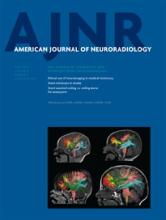Research ArticleMethodologic Perspectives
Open Access
Guidelines for the Ethical Use of Neuroimages in Medical Testimony: Report of a Multidisciplinary Consensus Conference
C.C. Meltzer, G. Sze, K.S. Rommelfanger, K. Kinlaw, J.D. Banja and P.R. Wolpe
American Journal of Neuroradiology April 2014, 35 (4) 632-637; DOI: https://doi.org/10.3174/ajnr.A3711
C.C. Meltzer
aFrom the Departments of Radiology and Imaging Sciences (C.C.M.)
bNeurology (C.C.M., K.S.R.)
cPsychiatry and Behavioral Sciences (C.C.M., P.R.W.)
G. Sze
hDepartment of Diagnostic Radiology (G.S.), Yale University School of Medicine, New Haven, Connecticut.
K.S. Rommelfanger
bNeurology (C.C.M., K.S.R.)
K. Kinlaw
ePediatrics (K.K., P.R.W.)
J.D. Banja
dRehabilitation Medicine (J.D.B.)
P.R. Wolpe
cPsychiatry and Behavioral Sciences (C.C.M., P.R.W.)
ePediatrics (K.K., P.R.W.)
fMedicine (P.R.W.)
gSociology (P.R.W.), Emory University, Atlanta, Georgia

References
- 1.↵
- Kraus M,
- Susmaras T,
- Caughlin B,
- et al
- 2.↵
- Mohamed F,
- Faro S,
- Gordon N,
- et al
- 3.↵
- Karim A,
- Schneider M,
- Lotze M,
- et al
- 4.↵
- 5.↵
- Woodward N,
- Karbasforoushan H,
- Heckers S
- 6.↵
- Korgaonkar M,
- Grieve S,
- Etkin A,
- et al
- 7.↵
- 8.↵
- Anderson JS,
- Ferguson M,
- Lopez-Larson M,
- et al
- 9.↵
- Jovicicha J,
- Czannera S,
- Grevea D,
- et al
- 10.↵
- 11.↵
- McCabe D,
- Castel A
- 12.↵
- Weisberg DS,
- Keil FC,
- Goodstein J,
- et al
- 13.↵
Ethical clinical practice of functional brain imaging: Society of Nuclear Medicine Brain Imaging Council. J Nucl Med 1996;37:1256–59
- 14.↵
ACR Practice Guideline on the Physician Expert Witness in Radiology and Radiation Oncology. Revised 2012. http://www.acr.org/∼/media/ACR/Documents/PGTS/guidelines/Expert_Witness.pdf. Accessed November 26, 2012
- 15.↵
- 16.↵
Guidelines for expert witness testimony in medical malpractice litigation: Committee on Medical Liability—American Academy of Pediatrics. Pediatrics 2002;109:974–79
- 17.↵
- 18.↵
- Feld A,
- Carey W
- 19.↵
- 20.↵
Austin v American Association of Neurologic Surgeons, Lexis 12143 (US App 7th Cir 2001)
- 21.↵
- 22.↵
- 23.↵
- Williams M,
- Mackin G,
- Beresford H,
- et al
- 24.↵
- Lindberg DM,
- Lindsell CJ,
- Shapiro RA
- 25.↵
- Hugh T,
- Dekker S
- 26.↵
- Vohs K,
- Mead N,
- Goode M
- 27.↵
- 28.↵
- 29.↵
- Kesselheim A,
- Studdert D
- 30.↵
- Shore S
- 31.↵
- Ganis G,
- Rosenfeld J,
- Meixner J,
- et al
- 32.↵
fMRI Evidence Used in Murder Sentencing. 2009. ScienceInsider. http://news.sciencemag.org/scienceinsider/2009/11/fmri-evidence-u.html. Accessed November 26, 2012
- 33.↵
- Feigl GC,
- Hiergeist W,
- Fellner C,
- et al
- 34.↵
- Brown T,
- Murphy E
- 35.↵
- Vernooij M,
- Ikram M,
- Tanghe H,
- et al
- 36.↵
- Henderson C,
- Epstein J
- Morse S
- 37.↵
- Morse S
- 38.↵
- Carter Snead O
- 39.↵
- Johnson S,
- Blum R,
- Giedd J
- 40.↵
- DeKosky S,
- Ikonomovic M,
- Gandy S
- 41.↵
- Arfanakis K,
- Haughton V,
- Carew J,
- et al
- 42.↵
- Bazarian J,
- Zhong J,
- Blyth B,
- et al
- 43.↵
- 44.↵
- Levin H,
- Wilde E,
- Troyanskaya M,
- et al
- 45.↵
- 46.↵
- Field A,
- Filippi C,
- Kalnin A,
- et al
- 47.↵
- 48.↵
- Bruce D,
- Zimmerman R
- 49.↵
- Findley KA,
- Barnes PD,
- Moran DA,
- et al
- 50.↵
- Barnes P
- Barnes P
- 51.↵
In this issue
American Journal of Neuroradiology
Vol. 35, Issue 4
1 Apr 2014
Advertisement
C.C. Meltzer, G. Sze, K.S. Rommelfanger, K. Kinlaw, J.D. Banja, P.R. Wolpe
Guidelines for the Ethical Use of Neuroimages in Medical Testimony: Report of a Multidisciplinary Consensus Conference
American Journal of Neuroradiology Apr 2014, 35 (4) 632-637; DOI: 10.3174/ajnr.A3711
0 Responses
Jump to section
Related Articles
- No related articles found.
Cited By...
This article has not yet been cited by articles in journals that are participating in Crossref Cited-by Linking.
More in this TOC Section
Similar Articles
Advertisement











